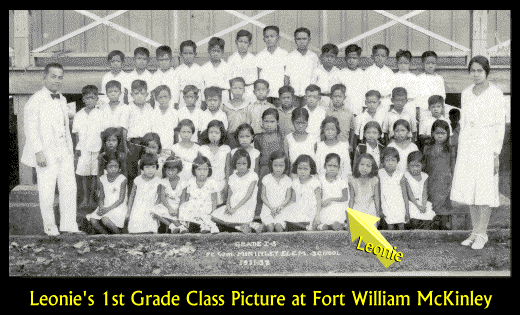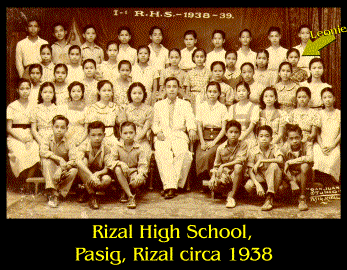Too often we learn about historical events from texts that were written after piles of primary documentation have been scoured clean of the participants' voices, analyzed and a story constructed from the scattered minutiae. This is done in part to assist others in the understanding of a particular event through an attempt to focus on the more important details and some effort made at impartiality. The following story is a departure from the above. It is Aling* Leonie's story. She has been generous enough to be honest and forthcoming about events that have touched her life during an important historical event which she leaves to posterity. Her story honors the memory of those who suffered during the war. We would like to add that her story does honor to herself as well. (Although her story is told here in the first person, it is derived from interviews with her).
* aling is a Filipino term of respect for an elder woman who is not related to you.
So you want to know what life was like in the Philippines back then? Back under the Japanese? Well, let me tell you what happened. I was a young woman then. The son of a sergeant in the American forces. I was born in 1924, the second daughter of Marcelo Faulve and Segunda Alborida. My story really begins with them:

Marcelo was the youngest of four sons born to my lolo Faulve in the province of Capiz, in the Visayan Islands. His father owned lots of land and was a barangay captain [barangay and barrio are synonymous terms, one Tagalog the other Spanish, and are essentially administrative units smaller than a city (these terms are used interchangeably in this story)]. In 1917, when Marcelo was eighteen he left home and went to Manila to join the Philippine National Guard which was organized by the Americans. He was trained at Fort William McKinley [renamed Fort Bonifacio after the Philippines gained its independence]. After his training, he was stationed at Camp Eldridge in Los Baņos, Laguna. Segunda Alborida was just sixteen-years old when Marcelo first saw her performing in the sarsuwela [or zarsuela, is a musical drama] at the town's Fiesta. She had very long hair and was brandishing a sword while she danced to the accompaniment of music. She had already had suitors when Marcelo approached her brother to ingratiate himself with the family. Back then, there was no such thing as dating so the man had to court the family of the woman he favored to convince them that he was a good match for their daughter and sister. Segunda's father had already passed away sometime before so her brother was the head of the household at that time. It was a bit difficult for Marcelo because he didn't speak Tagalog* very well. Since the man, in those days, was not permitted to date a woman he was interested in, he would ask the neighbors about the girl and sometimes try to do some work near the house to steal glimpses of her. There was also a saying, "Filipino women no touch, once you touch you have to marry." Segunda was young and naīve and didn't pay much attention to her suitors. Years later she told us that our father had caught her off guard and kissed her so they got married. [*Tagalog is the dominant dialect of Luzon Province at the time but not yet the national language. In fact Visayan, Marcelo's dialect, was more widely spoken than Tagalog]
Even though Segunda was a young bride by our standards today, she had already been a mother since she was ten-years old. It didn't happen the way you might surmise. Her elder sister died during childbirth, and Segunda became responsible for the child for the eighteen years, when she married. I'll tell you more about them later. From 1922 to 1945, my parents had twelve children including me. All but two, who died during their infancy, are still alive today [January, 1997]. I am the eldest surviving daughter.

In 1926 my father, Corporal Faulve of the Philippine Scouts, was transferred to Fort [William] McKinley. He was given the nickname, "chicken doctor", because of the skills he picked up after having studied agriculture at the Los Baņos School of Agriculture [now the University of the Philippines, Los Baņos]. Before long he was promoted to Sergeant and was given a new nickname. He boxed a higher ranking officer and was demoted for three months before having his rank reinstated, but was also given the new nickname, "bully". My father was a very industrious man, who was always trying to learn something new. He was a high school graduate at a time when it was uncommon, he learned steno-typing at Greg Institute, he studied baking so that he would be promoted to Staff Sergeant, and he was placed in charge of the first motorized unit at the 14th Engineers of Fort McKinley after studying automotive engineering at an army school in Manila.
It was nice growing up in the base at Fort McKinley. The children were all very close and had no malice towards each other. School was segregated so the Filipino children were educated in one place and the whites were educated in another. Our teachers were Filipino, but there was an American army man who would occasionally visit the classroom to supervise. There was a little rivalry between the American children and us and we would tease and fight each other when they came to learn industrial arts which was in our part of the school only. Sometimes we would play hooky so we could go pick blackberries on a tree behind the "Prophylactic Station". We didn't know what "prophylactic" meant at that time, but we knew how to read so we referred to the building by its sign. The military police station was located next door to the Prophylactic Station and it overlooked a brook which was our other favorite place to go when we played hooky so we had to be careful. Sometimes we weren't careful enough and the MPs would grab us by our large collars and haul us off to the principal's office.

Since my father was in the army, we had a very strict, regimented childhood. Every morning before we entered our classrooms for school, a bell would ring, then we would pledge allegiance to the American flag and sing "America the Beautiful." At 6 p.m. every day, a bugler would play taps and everyone on the base would stop what they were doing, place their hand over their heart and stand at attention facing the direction of the U.S. flag which was being lowered. I never saw my father wearing anything other than his uniform or his overalls which he wore when he was off duty. He had to sleep in the barracks when he was on duty, but stayed with us in the soldiers' family housing when he was off duty. Each house was allocated a small lot and we had a garden of sugar cane and vegetables, a half dozen turkeys and a couple dozen chickens. My father would sell the chicken eggs in Manila. The housing was divided into barrios just like the housing communities outside the base throughout the Philippines.
In 1932, the army built new, duplex houses to replace the temporary housing that we all lived in. We didn't have refrigerators so we had to get our daily ration of ice at noon from the corner store to use in our ice box. The non-com [non-commissioned] officers were given rations of fire wood. Doctors and medical men always inspected our homes for cleanliness, sanitation, and fire hazards. One soldier's wife left something frying on her stove when she went out to fetch her ice and the cogon (cogon is also known as "elephant grass") caught on fire in her house. In the panic of the moment, her child grabbed a bottle of clear liquid, thinking it was water, and sprayed the fire with gasoline. A couple of dozen homes were destroyed in that fire including ours along with nearly everything we owned.
The only motorized transportation on the base at this time were these large 6x6 trucks (the jeeps came right before the war). Whenever there was a typhoon the trucks would transport us, but large molas [mules] were the most common form of transportation for soldiers for most of the time we were at Fort McKinley. One time these white* soldiers who were friends of my father put me up on top of one of these molas. They gave me an apple and let me ride on its back as they exercised it. [* Filipinos commonly use the term "puti, or "white," to refer to Europeans and Euro-Americans. This is most probably based on a response to being called "brown" by the puti in the first place]
Rumors of an impending war with Japan began about a year or so before Pearl Harbor was attacked and the Japanese invaded the Philippines. Japanese submarines had been seen off the coast of Davao months or even a year before December, 1941. One day when my mother was at the base store, she heard this incident unfold: A truck driver entered through one of the gates of the base with a valid pass. The driver said he had to make a rice delivery. The man who ran the store was a Chinese man and the driver of the rice delivery truck and his passenger were believed to be Chinese as well for some reason, but when the Chinese man at the store tried to speak Chinese to the two men they couldn't understand him. He called the MPs and they took the two men away. I don't know if they were actually spies or not, but there were many spies in the area at the time and the base was almost defenseless because the soldiers were on maneuvers in Bataan for the annual exercises held there.

[On November 26, 1941, the American military command in the Philippines was notified that diplomatic relations between Japan and the United States were deteriorating rapidly and that all troops should be alerted and prepared to meet a surprise attack.-see below The Wainwright Papers, Volume 1].

